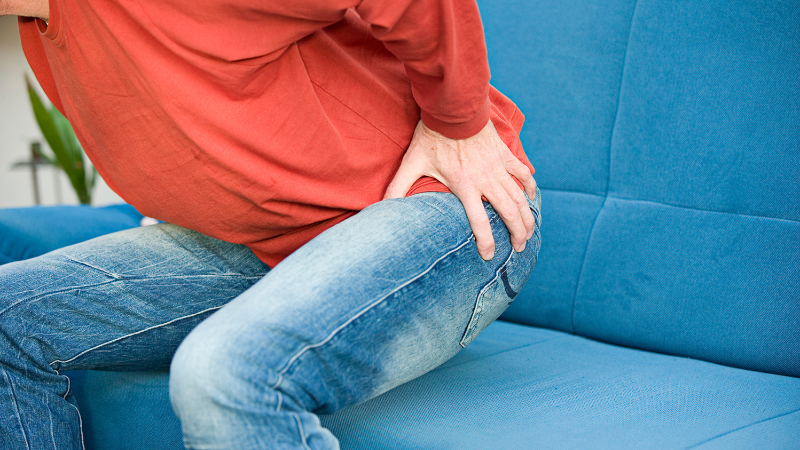Understanding A “Pain in the Butt”: Sciatica
Have you ever experienced a literal pain in the butt? You’re not alone. LBP, or sciatica, is the number one reason why people seek out medical attention.1 By getting into physical therapy as early as possible, we have the greatest chances of alleviating the pain completely along with teaching you how to prevent future occurrences.
Low back pain or sciatica can (literally) be a pain in the butt. The varied symptoms and limitations that accompany your pain can represent a multitude of diagnoses. It is important to determine the exact cause of your symptoms as certain movements or exercises will be appropriate for one diagnosis but not the other. Getting into physical therapy sooner than later will help determine the exact cause and get you on your way to feeling better as fast as possible.
The physical therapy evaluation findings, coupled with the subjective information from the patient, will lead to the appropriate treatment regimen. The physical therapist will ask discerning questions such as, “What hurts more, sitting or standing? Lying on your back or side? Does your back hurt when you sneeze or cough?” These questions help determine what may be causing symptoms, whether it’s one or more of the common diagnoses described in the tables below or something else that may require a return to your MD for more testing such as magnetic resonance imaging (MRI).
As I looked for research to back up the claim that low back pain is the most common medical complaint, I happened to be at my son’s cross-country meet. I began talking with another boy’s father, who was a runner like me. And like me, he has not been able to run because of an injury.
He said that he had been having severe hamstring pain and some low back pain. He was seeing a chiropractor and receiving electrical stimulation and Augmented Soft Tissue Manipulation (ASTYM), but had not seen much improvement. He felt the chiropractor was not getting to the “root” of the problem. He didn’t know if his pain was coming from his back or just a severe hamstring strain.
Common Back Diagnoses
After this conversation, I decided to shift my article slightly to describe the most common back diagnoses (dx) I see and compare them to hamstring strain/proximal hamstring tendinopathy. The following table lists the most common symptoms associated with each diagnosis and some immediate recommendations to follow before receiving medical attention.
There is quite a bit of overlap. There are other diagnoses that might have some of these same symptoms as well, such as a spinal tumor, degenerative disc disease, and osteoporosis, which I do not address here. If more serious diagnoses are suspected, further testing will be recommended by the MD, or the physical therapist will send the patient back to their doctor.
Diagnosis: Herniated Lumbar Disc
| Symptoms | Dos | Don’ts |
|---|---|---|
| Stiffness, viselike Lower Back Pain | Avoid painful positions | “Bend/flex low back be sure to hinge through hips” |
| Pain worse with sitting than standing | “Brace self when sneezing or coughing” | Lift heavy objects |
| ” Pain/numbness/tingling (sciatica)down back of leg” | “Lie on side with pillow between legs” | Stretch hamstrings |
| “Lying on one side worse than other side” | Lie on back with pillow under knees | |
| Pain with sneeze or cough | Use heat or ice on back, whichever feels better | |
| sciatica without low back pain | Walk, if does not increase pain | |
| “Lower Back Pain upon waking in the morning” | Walk in pool if does not increase pain | |
| “Decreased light-touch sensitivity in leg” | Roll on side to get out of bed | |
| Weakness anywhere in leg | “Progressive core stabilizing and strengthening exercises” | |
| Trip over toes | ||
| Decreased leg reflexes | ||
| Bowel or bladder changes |
“Diagnosis: SI Joint Dysfunction (SI=sacroiliac)”
| Symptoms | Dos | Don’ts |
|---|---|---|
| Pain at SI joint | Avoid painful positions | “Do activities that spread legs apart, such as getting out of car one leg at a time” |
| “My back feels like it needs to be cracked” | “Lie on side with pillow between legs” | Stretch hamstrings |
| “Pain/numbness/tingling (sciatica)down back of leg” | “Lie on back with pillow under knees” | Lift heavy objects |
| Pain lying on back | “Use heat or ice on back whichever feels better” | Frequent stair climbing |
| Pain in butt/piriformis muscle | “Walk if does not increase pain” | |
| Pain climbing stairs | “Walk in pool if does not increase pain” | |
| Headache | Roll on side to get out of bed | |
| Recent fall onto butt | “Progressive core stabilizing and strengthening exercises” | |
| Recently hit head |
“Diagnosis: Lumbar Spinal Stenosis”
| Symptoms | Dos | Don’ts |
|---|---|---|
| Lower Back Pain | “Walk in pool if does not increase pain” | Bend low back backwards |
| “No pain with sitting; standing/walking increases pain” | Roll on side to get out of bed | Stretch hamstrings |
| “Pain/numbness/tingling (sciatica) down front or back of thighs; “”Pain at bottom of butt at sits bone (ischial tuberosity)””” |
“Walk if does not increase pain” | Lift heavy objects |
| “Low back pain when wake in the morning” | Avoid painful positions | |
| “Pain decreases as begin to move after waking” | “Lie on side with pillow between legs” | |
| “Long walks greater than 10 minutes increase leg symptoms” | “Lie on back with pillow under knees” | |
| Weakness in leg(s) | “Use heat or ice on back – whichever feels better” | |
| Decreased leg reflexes | “Progressive core stabilizing and strengthening exercises” | |
| Trip over toes | Before getting out of bed in morning, stretch low back; 1. hug knee to chest 2. roll bent knees side to side |
“Diagnosis: Strained Hamstring or Proximal Hamstring Tendonopathy”
| Symptoms | Dos | Don’ts |
|---|---|---|
| Hurts at toe-off during walk/run | “Exercises that don’t increase pain, e.g., spin, swim, weight-lifting, etc.” | Stretch hamstrings |
| Pain in sitting | Ice tender areas | Do activities that increase pain |
| Pain bending over | Kinesiotape hamstring | |
| “Pain at bottom of butt at sits bone (ischial tuberosity)” | Hip flexor and IT band stretches | |
| Hamstring weakness | “eccentric hamstring exercises” | |
| “Tenderness at hamstring attachment on sits bone” | dynamic hip and ankle mobility exercises | |
| No sensory issues | “Progressive core stabilizing and strengthening exercises” | |
| Sleeping is usually fine in any position |
Physical Therapy to Kick That Pain in the Butt
In general, the PT treatment for each of these issues is the same: manual therapy; education on how to function daily; exercises to improve mobility, balance, and core strength; and, most importantly, neuromuscular reeducation (teaching your body how to work together as a whole). However, while some exercises are appropriate for one diagnosis, those same exercises may aggravate others. There is no one-size-fits-all when it comes to an exercise program for sciatica, low back pain, or proximal hamstring tendinopathy.
Manual therapy techniques are also specific to each diagnosis, but there is greater overlap. For instance, I find everyone needs work on their sacroiliac (SI) joint, regardless of their primary diagnosis. The sacroiliac joints are part of the pelvis at the base of the spine. Like the floor of a house, if it’s not level, then everything above it will be thrown off. Once the pelvis’ position is balanced, manual therapy becomes more symptom-specific.
Research shows that physical therapy can be very successful much of the time for each of these diagnoses.2 Physical therapy is even more successful if a patient gets into the office sooner than later. If you suspect you have any of the above issues, give us a call for an appointment where we’ll be happy to assist you in healing.
In the meantime, download these eBooks for more tips how to function daily to decrease or avoid pain:
9 Things You Can do for Low Back Pain and Sciatica
Mindful Tips for Pain-Free Living
Better Balance and Fall Prevention Guide
Common Diagnoses Reference
1. Hanney WL, Morey JK, Beekhuizen KS. Implications for physical activity in the population with low back pain. Am J Lifestyle Med. 2009;3(1):63-70.
2. Balthazard P, de Goumoens GR, Rivier G, et al. Manual therapy followed by specific active exercises versus a placebo followed by specific active exercises on the improvement of functional disability in patients with chronic non specific low back pain. BMC Musculoskelet Disord. 2012;13(162).







Leave a Reply